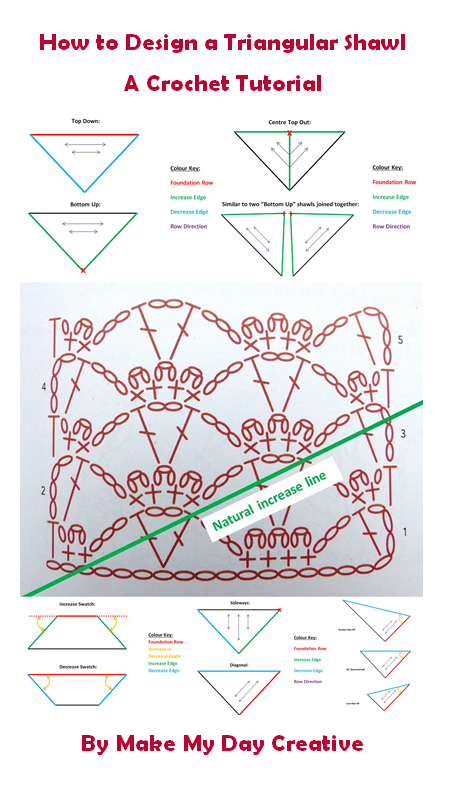
How to design Triangular Shawls – A tutorial by Make My Day Creative. This tutorial works for knitting too!
Triangular shawls are a great way to place to start with designs involving increasing and decreasing. It’s easy to see if your design is coming out how you like from the beginning. And you can modify them to make scarves in the event of a yarn shortage!
Last time I looked at how to increase and decrease in a stitch pattern. Once you have your increase or decrease figured out you can turn your stitch pattern into a triangular shawl. All you need to do is consider a few details such as the angle of your increase/decrease, your desired overall look, and then choose a construction type. Your yarn choice may also affect your construction preference particularly if you are using a gradient or long self-striping yarn.
What is the angle of decrease/increase?
When I talk about the angle of increase or decrease, I mean the angle made measuring from the horizontal row to the edge. Lay your sample swatch out with your foundation row at the top. If you are increasing then the angle is measured from the horizontal edge projected out to the edge of the work (i.e. not across the work). For decreasing, the edge is measured from the horizontal row to the edge of the work (i.e. across the work).
[I have labelled the angles this way so that an increase and decrease made in the same pattern will both have the same angle – e.g. if you made a sample in sc and worked the decrease as sc2tog at the start of a row, and an increase of (2sc) in one stitch at the end of the row, the angle of decrease at one end and increase at the other equal each other.]
Construction Types:
There are several ways of making a triangle shape: top down, bottom up, centre top out, sideways, diagonal – and I’m sure there are more but I’ll stick to these for now! Each of these shapes will require your stitch pattern to be increased, or decreased, or both.
I have put together a handy pdf Quick Reference Guide on these types (download from the bottom of this page).
Top Down
A top down construction begins by making a foundation row which is the length of the top edge. This is then decreased on both sides of the row so that subsequent rows get shorter and shorter until you end up at the tip. The foundation row can be a bore but subsequent rows get faster and faster.
This construction has the benefit that you can stop part of the way down your shawl and turn it into a scarf with tapered ends if you find yourself short on yarn. A trapezium shape can also be turned into a multiway scarf/shawl, like my Multiplicity Lace Shawl.
If your decrease angle is 45° or less this shawl will work well. The more acute your angle is the shallower your shawl will be. Summer Sprigs Lace Scarf is made with an acute decrease angle and is quite shallow for its wingspan. If your decrease angle is more than 45° then the shawl will be very long for its wingspan.
Bottom Up
A bottom up shawl begins at the centre corner opposite the long edge and increases with each row until your shawl is the desired size. This construction has the benefit over a top down method of avoiding a long foundation row, but if you run out of yarn you could wind up with a neckerchief rather than a shawl!
You will need to begin by making a single repeat of your pattern. If your pattern repeat is long (e.g. more than 10 sts) but you wish your shawl to end in a sharp point, you may want to crochet a small plain triangle (mesh works well) as the foundation.
As with a top down construction, if your increase angle is 45° or less this shawl will work well. The more acute your angle is the shallower your shawl will be. If your increase angle is more than 45° then the shawl will be very long for its wingspan.
Centre Top Out
A centre top out shawl is made by beginning at the centre of the long edge. An increase is made at the start and end of each row. A double increase is made at the centreline. The shawl then grows out and down from the foundation. Rows are worked diagonal to the top edge, reflected at the centre line. (See my Atlantic Lace Shawl as an example.)
Make your foundation row a small, odd number of stitches (e.g. 5 or 7) and increase until you have enough for two pattern repeats, plus a central stitch.
Centre top out can look confusing. I tend to think of it as two bottom up shawls joined together along their short sides using a central stitch. If you can make a bottom up shawl then you can make a centre top down shawl!
The increase angle is quite important for this construction type. If it is not 45° (or very near it) then the shawl will not be triangular. An increase angle of less than 45° will also work, but instead of being a triangular shape the top edge will be dipped towards the tip. This is actually a nice shape to make because the ends can wrap around the body more easily.
Sideways
A sideways shawl is made by starting at the tip of the long edge and increasing on one side only. Once the central point has been reached (make sure you use less than half your yarn!) then decreases are made on the same side of the work. Working a shawl this way makes rows which run vertically up and down the shawl. To ensure you get a symmetrical shawl, make sure your decrease and increase angle are the same as each other!
This construction type is a good option if your increase and decrease angle are more than 45°. The greater the angle, the shallower the shawl will turn out to be.
Diagonal
A diagonal construction is worked by making a foundation row which is the length of one of your short sides. This is then decreased on one side only – this side becomes the long top edge. Rows run diagonally across the shawl – in a similar manner to my Shooting Stars cowl (although this is a different construction type the effect is similar).
If you are looking for a symmetrical shawl then you will need to use a stitch pattern which has a decrease angle of 45°. However, asymmetric shawls can be an interesting alternative, so this is a good option if your angle is much bigger (e.g. 60°) or smaller (e.g. 30) than 45°. I say this because that way the asymmetry looks like it was on purpose and not an accident!
For asymmetric shawls with a large decrease angle (more than 45°), the foundation row will work out as the shortest edge and for asymmetric shawls with a small decrease angle (less than 45°), the foundation row will work out as the second longest edge.
I hope you are enjoying this series! Do let me know if there are any subjects you would like me to cover which I have not yet gone into. Upcoming posts are on selecting yarn and hooks!
[For previous posts in this series please click here]
Downloadable Quick Reference Guide: Triangular Shawls – A Quick Reference Guide

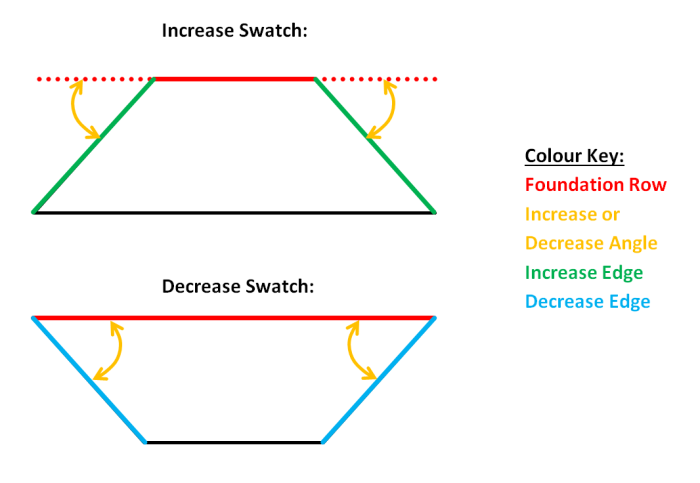
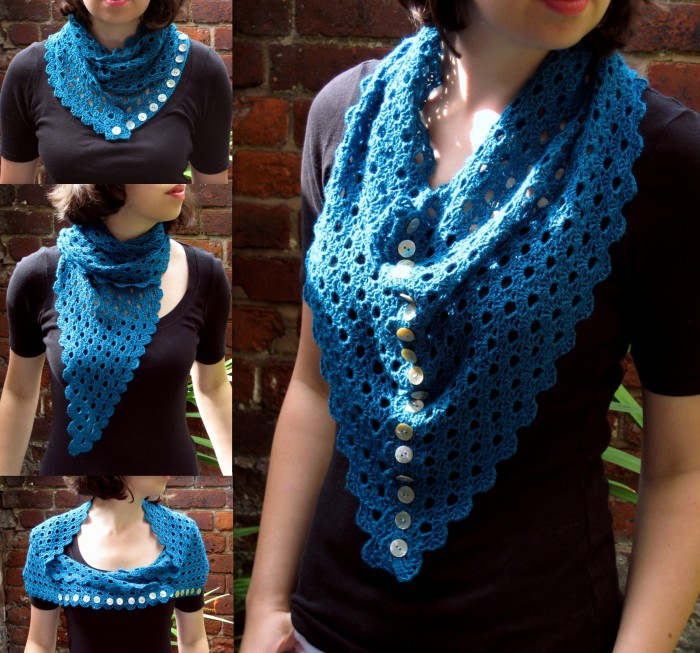
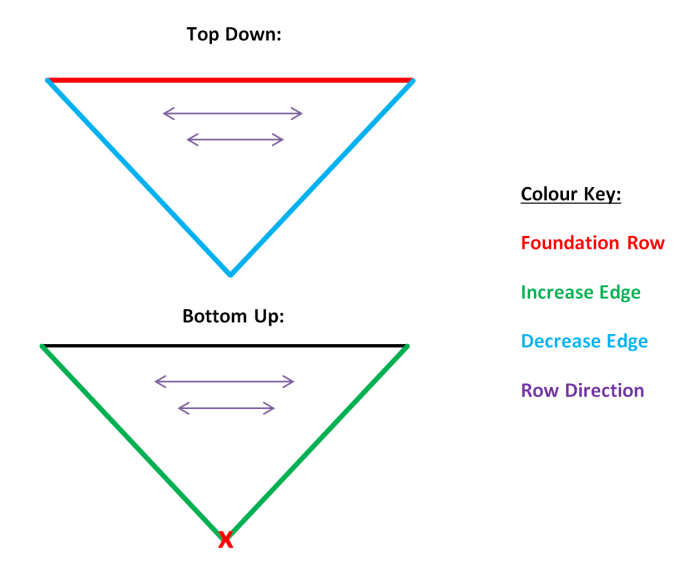
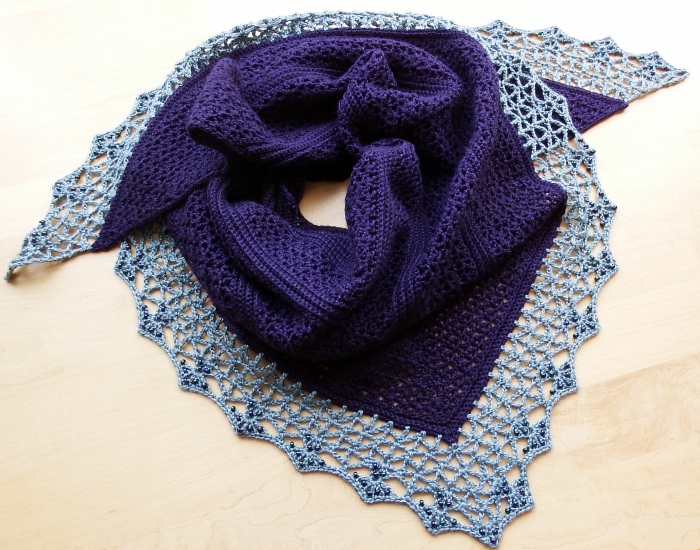
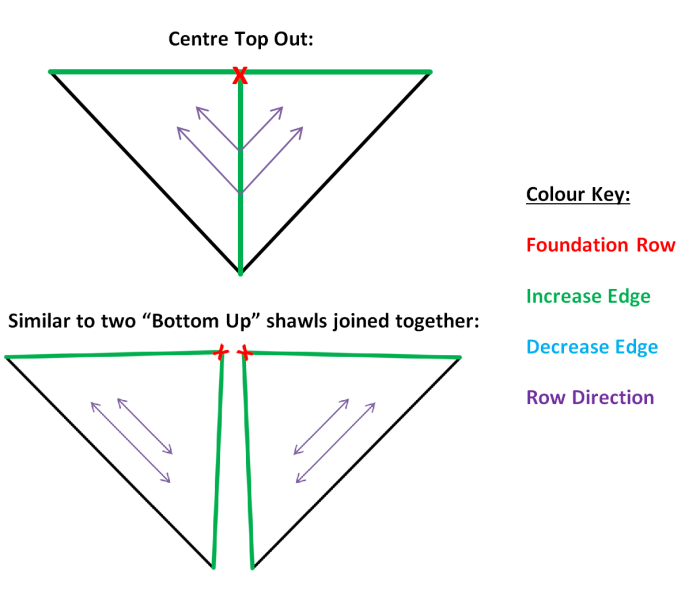
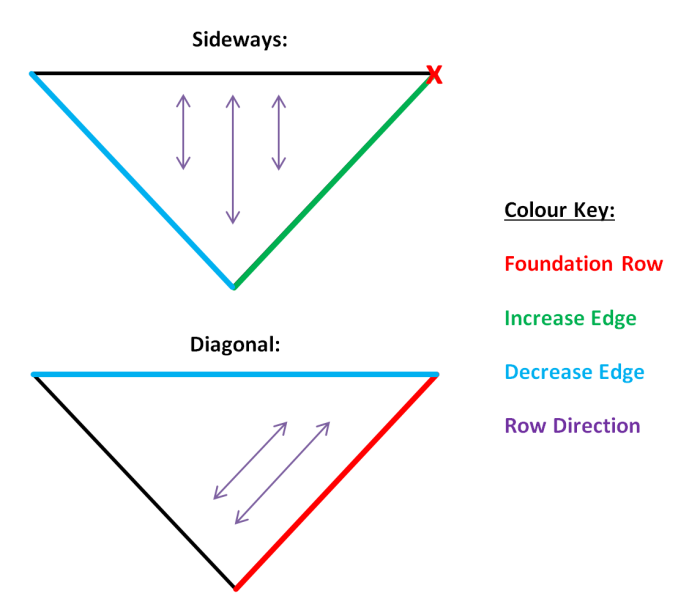
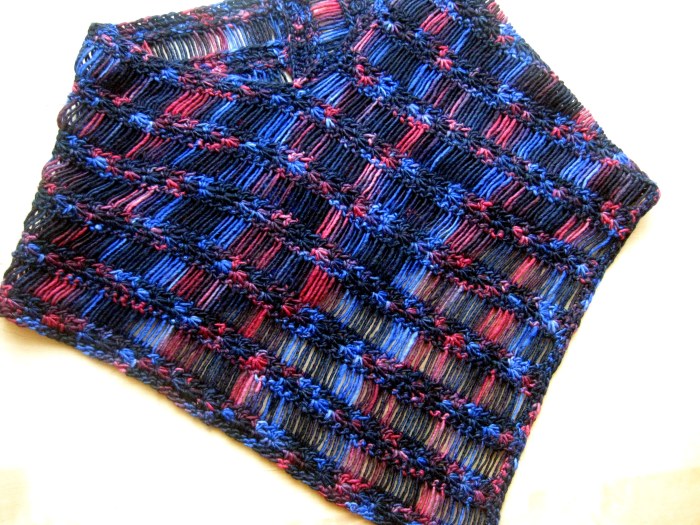
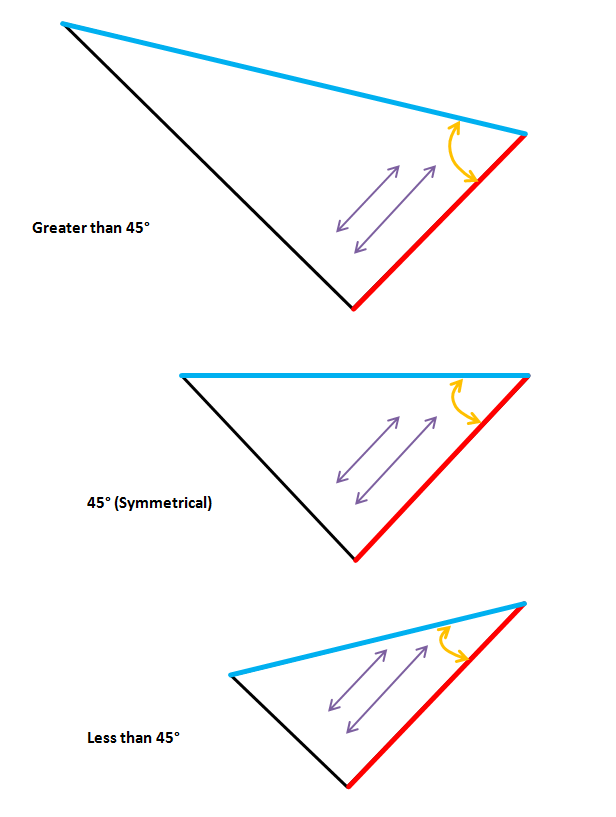



wow this article is really very useful.. will bear in mind if I ever am able to design my own crochet shawl. thank you for sharing. ;)
I’m glad you found it useful! Give designing your own a try next time you see a stitch you like :)
Thank you ever so much for this post. It is so helpful! Triangle scarves seem to be a favorite among many of my friends and family!
I’m glad you found it useful! :)
Hi Esther; I’m *finally* catching up with your series, and it just keeps getting better! Thanks for the bonus post; MyPicot has a stitch pattern I’d like to work with, and your instructions for finding the natural increase/decrease lines really helped. If your interested, it’s “2060 Openwork & Lace Pattern” on Ravelry. It’s a nice leaf pattern, which would make a great shawl, just add a border and a flower edging. :-)
Thanks again, and I look forward to your next installment.
Hi Korina! I’m glad you have found the series helpful :) your pattern sounds lovely, I’m off to check it out now!
I think your increase/decrease series is the best I’ve come across. There are so many fabulous crochet stitches out there, but I don’t want to keep making blankets & scarves. I want to be able to use those stitches in anything I want to make, so I’m hoping this series will click for me.
I want to increase from the tip up on a triangle shawl, but am confused as to what kind of increase goes where. In my case there are generally dc (as opposed to sc or dc) in the row of the pattern. So do I start increasing with dc or with chains & end with dc. I can’t figure out what stitches do what. Thanx for any help. Oh, The stitch I’m using is the Trestle Stitch from newstitchaday.com
I meant to say “as opposed to dc or tc” (US). Sorry. Thought I had proofed it before I posted.
Still wrong. Should be “sc or tc”. Good grief!!
Hi Patty! I’m glad you are finding this series helpful! I have had a look at the stitch you mention. You haven’t picked an easy one to start with! I say this because the stitch pattern has strong vertical lines (the dc stitches are stacked on each other) and quite a lot of empty space – I’d probably describe the pattern as a block based mesh. This means that it doesn’t have a particularly strong “increase line” (see my previous post). This doesn’t mean that it isn’t possible to work a bottom up triangular shawl, it just means it is harder! The way I would approach this is to make a large chart of the stitch pattern in pencil. I’d then pick the point I want to start and erase the sides so I’m left with a triangle shape symmetrical on both sides. Then you need to join each row to the next – in this case it would probably be by a longish chain on one side and a tall stitch at the other (maybe a dtr) which probably go across one of the largish spaces. Once you have a plan, try making a sample to check you are working long enough chains/tall stitches or vice versa so that your edge isn’t too tight or too loose and adjust accordingly. Hope that helps; sorry this was long! :)
thank you i’ll try to do that and see what happens. What if I went the other direction, starting from the other (long) end and did decreases. Would that work better in your opinion? Some people say decreases are easier than increases.
I think it would be easier, and I agree that top down is usually easier – because you are mostly subtracting parts of the pattern rather than trying to expand it! Play around with it and see what happens :)
Pingback: Winter Buds Scarf Pattern | Make My Day Creative
Pingback: Arrow Tails Shawl | Make My Day Creative
formidable tout cela va pouvoir me servir ! je viens de découvrir votre blog grace à pinterest
à tres bientot